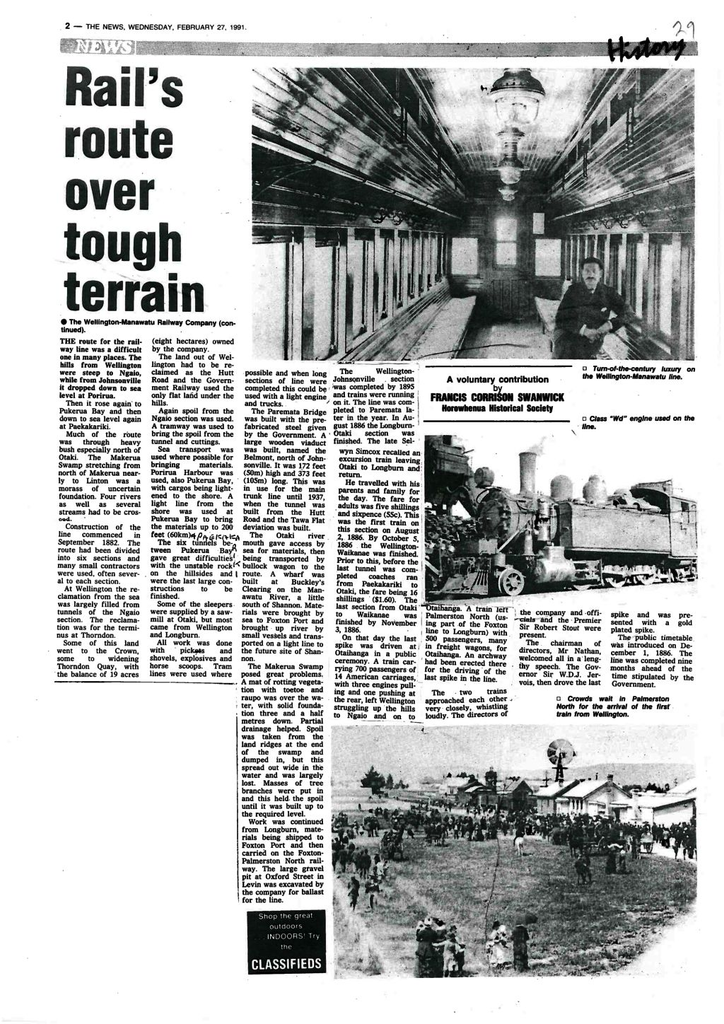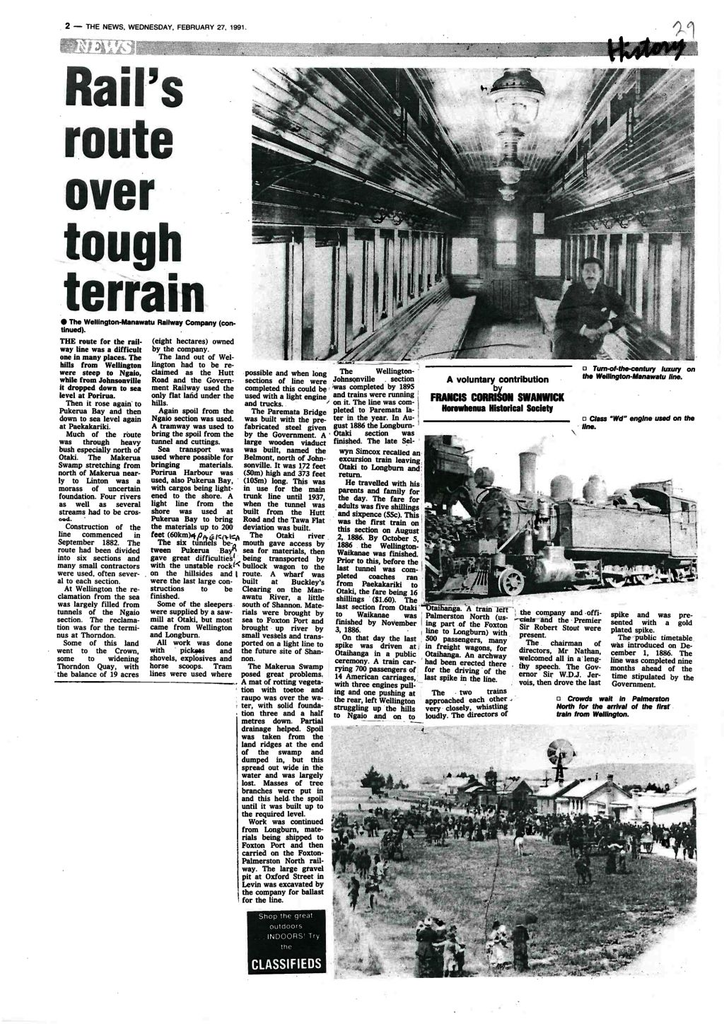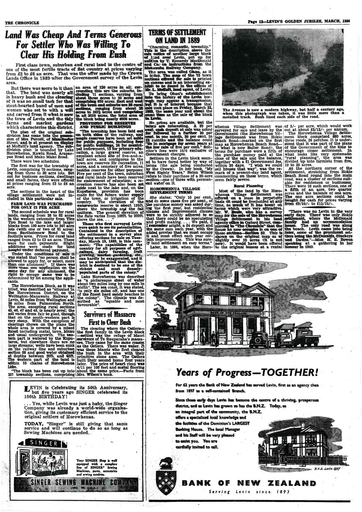Rail’s route over tough terrain
- Description
The text that follows is the content of the attached PDF.
The hills from Wellington were steep to Ngaio, while from Johnsonville it dropped down to sea level at Porirua.
Then it rose again to Pukerua Bay and then down to sea level again at Paekakariki.
 Much of the route was through heavy bush especially north of Otaki. The Makerua Swamp stretching from north of Makerua nearly to Linton was a morass of uncertain foundation. Four rivers as well as several streams had to be crossed.
Much of the route was through heavy bush especially north of Otaki. The Makerua Swamp stretching from north of Makerua nearly to Linton was a morass of uncertain foundation. Four rivers as well as several streams had to be crossed.Construction of the line commenced in September 1881. The route had been divided into six sections and many small contractors were used, often several to each section.
At Wellington the reclamation from the sea was largely filled from tunnels of the Ngaio section. The reclamation was for the terminus at Thorndon.
Some of this land went to the Crown, some to widening Thorndon Quay, with the balance of 19 acres (eight hectares) owned by the company.
The land out of Wellington had to be reclaimed as the Hutt Road and the Government Railway used the only flat land under the hills.
Again spoil from the Ngaio section was used. A tramway was used to bring the spoil from the tunnel and cuttings.
Sea transport was used where possible for bringing materials. Porirua Harbour was used, also Pukerua Bay, with cargos being lightered to the shore. A light line from the shore was used at Pukerua Bay to bring the materials up to 200 feet (60km)
The six tunnels between Pukerua Bay and Paekakariki gave great difficulties with the unstable rock on the hillsides and were the last large constructions to be finished.
Some of the sleepers were supplied by a sawmill at Otaki, but most came from Wellington and Longburn.
All work was done with picks and shovels, explosives and horse scoops. Tram lines were used where possible and when long sections of line were completed, this could be used with a light engine and trucks.
The Paremata Bridge was built with the pre-fabricated steel given by the Government. A large wooden viaduct was built, named the Belmont, north of Johnsonville. It was 172 feet (50m) high and 373 feet (105m) long. This was in use for the main trunk line until 1937, when the tunnel was built from the Hutt Road and the Tawa Flat deviation was built.
The Otaki river mouth gave access by sea for materials, then being transported by bullock wagon to the route. A wharf was built at Buckley’s Clearing on the Manawatu River, a little south of Shannon. Materials were brought by sea to Foxton Port and brought up river by small vessels and transported on a light line to the future site of Shannon.
The Makerua Swamp posed great problems. A mat of rotting vegetation with toetoe and raupo was over the water, with solid foundation three and a half metres down. Partial drainage helped. Spoil was taken from the land ridges at the end of the swamp and dumped in, but this spread out wide in the water and was largely lost. Masses of tree branches were put in and this held the spoil until it was built up to the required level.
Work was continued from Longburn, materials being shipped to Foxton Port and then carried on the Foxton-Palmerston North railway. The large gravel pit at Oxford Street in Levin was excavated by the company for ballast for the line.
The Wellington-Johnsonville section was completed by 1895 and trains were running on it. The line was completed to Paremata later in the year. In August 1886 the Longburn-Otaki section was finished. The late Selwyn Simcox recalled an excursion train leaving Otaki to Longburn and return.
 He travelled with his parents and family for the day. The fare for adults was five shillings and sixpence (55c). This was the first train on this section on August 2, 1886. By October 5, 1886 the Wellington-Waikanae line was finished. Prior to this, before the last tunnel was completed coaches ran from Paekakariki to Otaki, the fare being 16 shillings ($1.60). The last section from Otaki to Waikanae was finished by November 3, 1886.
He travelled with his parents and family for the day. The fare for adults was five shillings and sixpence (55c). This was the first train on this section on August 2, 1886. By October 5, 1886 the Wellington-Waikanae line was finished. Prior to this, before the last tunnel was completed coaches ran from Paekakariki to Otaki, the fare being 16 shillings ($1.60). The last section from Otaki to Waikanae was finished by November 3, 1886.On that day the last spike was driven at Otaihanga in a public ceremony. A train carrying 700 passengers on 14 American carriages, with three engines pulling and one pushing at the rear, left Wellington struggling up the hills to Ngaio and on to Otaihanga. A train left Palmerston North (using part of the Foxton line to Longburn) with 500 passengers, many in freight wagons, for Otaihanga. An archway had been erected there for the driving of the last spike in the line.
The two trains approached each other very closely, whistling loudly. The directors of the company and officials and the Premier Sir Robert Stout were present.
The chairman of directors, Mr. Nathan, welcomed all in a lengthy speech. The Governor Sir W.D.J.Jervois, then drove the last spike and was presented with a gold plated spike.
The public timetable was introduced on December 1, 1886. The line was completed nine months ahead of the time stipulated by the Government.
Identification
- Date
- February 27, 1991
Taxonomy
- Community Tags




